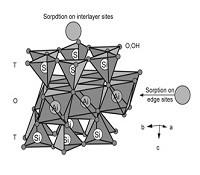Day 1 :
Keynote Forum
Mosongo Moukwa
PolyOne Designed Structures and Solutions LLC, USA
Keynote: Specialty films and multilayered structured: A review
Time : 10:30-11:15

Biography:
Abstract:
Global specialty and high performance films market is expected to reach $44.59 Bn by 2020, growing at 6.4% from 2014 to 2020, according to Transparency Market Research. Specialty and high-performance films are thin films with unique properties such as high or low heat conductivity, barrier properties, special surface properties, high purity, and mechanical properties. They are films made from various polymers such as polypropylene, polyamide, polyethylene, polyvinyl chloride, polycarbonate, ethylene vinyl alcohol, and polyester. Manufacturers have invested in research and development to create innovative products by developing multilayer films structures, combining low costs, high costs films, nanoparticles, and increased biopolymers. This is an overview of some modern aspects and trends in the development of specialty films and multilayered structures. Multi layered structures have allowed the construction of films with outstanding properties used in some of the toughest applications. They include barrier films, decorative films, and safety and security films. Their applications include food and cosmetics packaging, electronics, automotive and aerospace applications. A number of technical developments have taken place over the recent years to extend the performance of these types of films. Scientists and engineers are developing new materials in order to meet the evolving technical challenges, more stringent specifications, applications in harsher environments, demanding customer’s requirements and evolving environmental legislations. Possibilities are immense. Manufacturers are able to introduce new products with better performance by developing multilayer film structures, combining low cost and high cost films, and in some cases using of biodegradable polymers.
|
|
Figure: Structure of montmorillonite (phyllosilicate clay)
Networking & Refreshment Break 11:15-11:35 @ Foyer
Keynote Forum
Rene Hensel
INM – Leibniz Institute for New Materials, Germany
Keynote: Bio-inspired elastomeric adhesives for novel pick-and-place concepts
Time : 11:35-12:20

Biography:
René Hensel studied Materials Science at the TU Dresden, Germany. He was a fellow of the DFG Research Training Group 1401/2 at the TU Dresden and did his Doctorate at the Leibniz Institute of Polymer Research Dresden (IPF) and the Max Bergmann Center of Biomaterials Dresden (MBC). He was honored with the International Bionic Award 2014 from VDI for his PhD thesis on free-standing polymer membranes for omniphobic surface coatings. Since 2014, he has been the Deputy Head of the Program Division Functional Microstructures at Leibniz Institute for New Materials Saarbrücken, Germany.
Abstract:
Strong, but reversible adhesion to diverse counter surfaces has attracted the attention of several research groups worldwide. Inspired from concepts found in biology, micropatterned dry adhesives were identified as promising candidates, particularly due to their potential for the development of novel pick-and-place concepts. Whereas, fundamental principles and design guidelines of such adhesives to handle objects with smooth surfaces have already been reported in several reports; current developments undergo rapid progress towards applications in non-ideal conditions. Here, we will discuss the impact of surface roughness among other scenarios such as elevated operating temperatures and a reduced air pressure. As an example, surface roughness substantially reduces contact area; however, we found that an appropriate design of the surface pattern can lead to acceptable adhesion performances. By an intense interplay between experiment and theory, we studied a new composite design that maintains the structural concept of contact splitting in combination with soft materials to overcome critical issues in contact formation such as the strain energy penalty. Our developments demonstrate practical solutions for current limitations and might pave the way for emerging applications of bio-inspired pick-and-place systems in the real world.
Keynote Forum
Dukjoon Kim
Sungkyunkwan University Suwon, Korea
Keynote: Proton exchange membranes prepared from crosslinked and multi-block copolymers based on poly (arylene ether ketone)
Time : 12:20-13:05

Biography:
Dukjoon Kim has completed his PhD from Purdue University and Postdoctoral studies from Lehigh University. He was the Executive Director of Korea Polymer Society and now the Director of BK 21 Program in SKKU. He has published more than 170 papers in reputed journals on functional polymer material files.
Abstract:
Sulfonated poly(arylene ether ketone)s (SPAEKs) are for application of fuel cell electrolyte membranes. The chemical structure of the polymers synthesized is identified using 1H - and 19F- nuclear magnetic resonance spectroscopy, attenuated total reflection fourier transform infrared spectroscopy. Sulfonated mesoporous benzene-silica (SMBS) hygroscopic conductors are embedded in the membranes to lessen their dehydration in the low humid environment. The effects of sulfonation degree (SD) and hygroscopic conductors on the membranes properties are analyzed. The prepared SPAEK membranes are thermally stable up to 250oC without any chemical degradation. While the SPAEK membranes containing hygroscopic proton conductors exhibit superior conductivity to that of Nafion®117, those showed lower methanol permeability. Although the water uptake of the composite membranes is higher than that of the pristine membranes, no mechanical failure is observed. In the synthesis of SPAEK, the development of distinguished hydrophobic-hydrophilic phase separation is confirmed by small-angle X-ray scattering spectroscopy. SPAEK copolymer membranes show excellent oxidation stability.
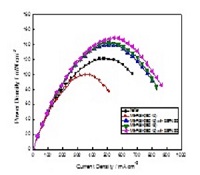
Figure: Cell performance of SPAEK membranes in comparison with Nafi on
Lunch Break 13:05-14:00 @ Athens
- Polymer Science- The Next Generation | Polymer Material Science and Engineering | Polymer Physics
Location: London

Chair
Linyong Song
University of Kansas, USA
Session Introduction
Linyong Song
University of Kansas, USA
Title: Self-strengthening dental adhesive: Mechanism and long-term behaviour
Time : 14:00-14:35

Biography:
Linyong Song is Ph.D. is in Polymer Chemistry from the University of Science and Technology of China. He received his B.S. from Tianjin University in Polymer Engineering. His main area of interest is Biomaterials, Interfacial Polymerization, Synthesis of Functional Monomers, Micro/Nano Structure Materials
Abstract:
The degradation of methacrylate-based dental adhesives via chemical and enzymatic hydrolysis leads to destruction of the integrity of the dentin/adhesive interface, loss of bond strength and failure of the composite restoration. Self-strengthening methacrylate-based adhesive systems were developed by introducing visible-light irradiation induced (photoacid-induced) sol-gel reaction. The self-strengthening mechanism and mechanical properties of copolymers were investigated by real-time Fourier transform infrared spectroscopy (FTIR) and dynamic mechanical analyzer (DMA), respectively. HPLC was used to determine cumulative amount of leached species. Time-temperature superposition (TTS) was employed to predict the long-term performance. The results indicated that with the incorporation of organosilane components, self-strengthening adhesives showed 1) significantly reduced leachable species (HEMA and BisGMA); 2) gradual increase in mechanical properties under wet conditions (neutral or acidic pH); 3) better long-term behavior predicted by TTS. In conclusion, the mechanical properties of this resin are reminiscent of living organisms such as marine invertebrates. These results provide valuable information for the development of dental adhesives with enhanced durability.
Hitesh R Patel
Ganpat University, India
Title: Formulation and evaluation of oral mucosal casein salt fi lm for the anti-diabetic activity
Time : 14:35-15:10

Biography:
Dr. H R Patel has completed his PhD study from S. K. P. C.P. E. R. Ganpat University (Pharmaceutical science) in Novembwe, 2009. He has worked on research Project in Polymer and Pharmaceutical Sciences funded by Government of India. He has 25 National and Interntional Research paper Publication. His topic of interest is in Formulation and Development of Sustained and Controlled release Drug Delivery System for oral mucosal drug delivery.
Abstract:
To develop the novel formulation in the era of modern drug delivery system with their biodegradable drug delivery, we have prepared the oral mucoadhesive formulation from the protein material like salts of casein. It has shown good compatibility and desire drug release with no side effect. Different concentration of sodium caseinate, calcium caseinate was added in a polymer mixture to prepare the films were evaluated for physical parameters. In-vitro diffusion studies of the patches were performed and the samples were analyzed by HPLC method. The cumulative percent drug release was plotted against time and the slope of the linear portion of the curve estimated by first order, korsemeyer’s equation and higuchi kinetics. The IR spectral data and DSC studies showed that there was no interaction between drug and utilized polymers. All the films were found to be flexible, smooth surface texture, transparent and uniform in weight and thickness. Among all formulations, formulations F4 shows 93.24% drug release at the end of 12 hrs. The films prepared from casein salt have shown a diffusion controlled release. Hence these formulations were further subjected for in-situ diffusion studies and in-vitro - in-situ correlation was carried out. Different kinetic models were used for the determination of release pattern. The present investigation resulted in the development of protein film for the drug delivery with good bioadhesive strength and further there is a scope to conduct the in-vivo diffusion studies by using various experimental animal models and correlate the in-vitro- in-vivo diffusion parameters.
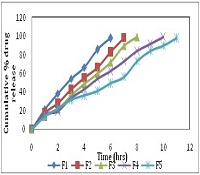
Figure: In-vitro drug release profile of insulin film
Girish N. Patel
Ganpat University, India
Title: Design and development of bilayer gastroretentive tablet containing metformin HCl and glipizide for the treatment of type II diabetes
Time : 15:10-15:45

Biography:
Dr. Girish N Patel is a Ph.D., M. Pharm and he completed his Ph.D from Hemchandracharya North Gujarat University, patan, Gujarat, India. His area of interest mostly lies in the field of Polymer Technology
Abstract:
The aim of the present research work is to develop and optimize a bilayer antidiabetic floating matrix tablet containing Metformin HCI (MET) as sustain release in one layer, using different grades of hydroxy propyl methyl cellulose (HPMC) by direct compression method, and glipizide as immediate release from the remaining layer. Immediate action of glipizide will be helpful to control excess sugar, which will be maintained by metformin action later on. Thus, the developed single tablet will be sufficient instead of three to four tablets of both drugs per day, and it will also increase patient compliance and therapeutic efficacy. The formulations of immediate release layer were prepared by using various super disintegrants i.e. crossprovidone, sodium starch glycolate, and croscarmellose sodium by direct compression technique. 32 full factorial design was used to optimize sustain release formulations of Metformin HCl. The ratio of polymer blend (X1) and content of gas generating agents blend (X2) were chosen as independent variables. The tablets were evaluated for in-vitro dissolution profile, in-vitro buoyancy studies, comparison of dissolution profiles, kinetic modeling and drug release mechanism. Different super disintegrants were used to prepared immediate release tablets of GPZ. Among these SSG (5%) give good disintegration and the GPZ was completely released within 1 hr. Among the different grades of HPMC investigated, significant difference in the resulting MET release profiles from the SR layer of tablets was found. This indicated that the viscosity of the polymer affects the drug release rate when the drug is water-soluble and the dose is high. The results conclude that bilayer gastro retentive tablet of Metformin HCl and Glipizide shows desirable release profile, good floating, and sustained effect in stomach. There is a further scope to conduct the in-vivo studies by using various experimental animal models and correlate the in-vitro- in-vivo correlation.
Kossi Nicolas ASSIGBE
University Grenoble Alpes, France
Title: Thermo-mechanical characterizations of polymers for microelectronics applications
Time : 15:45-16:10
Biography:
Kossi Nicolas ASSIGBE is an young researcher of 24 years born in TOGO with a diploma of mechanical design engineer (TOGO, 2014) and a master research in materials mechanics (France, 2015). Passionate about understanding the behavior of materials, I am now working on the temperature instability of the thermomechanical properties of polymer films used in microelectronics. I am a PhD student based at CEA (Commissariat of Atomic Energy and Alternative Energies) and SIMaP (Laboratory of Science and Engineering of Materials and Processes).
Abstract:
In microelectronics, 3D integration involves stacking different electronic components on a substrate. During the various steps of the process, bonding is carried out using several types of polymeric materials. The use of these materials can be advantageous: they are generally carried out at deposition temperatures lower than those of the other integrated materials and it is possible to integrate them in liquid form under components and then crosslink them. They also have the advantage of offering various mechanical properties, which make it possible both to protect certain components but also to produce more flexible layers if necessary. Conversely, they exhibit high coefficients of thermal expansion (CTE), which can lead to problems of reliability of the components. Moreover, their mechanical properties can change over time when the crosslinking annealing has not been optimized. Thus, their characteristics may be unstable when used in manufacturing processes. The aim of this work is to develop a method for studying the evolution of thermomechanical properties of polymers used in manufacturing processes as a function of temperature. In the first part of this work we carried out experimental measurements using a measuring equipment (k-SA MOS Thermoscan) to measure the evolution of the curvature of deposit materials on substrate. We carried out this study for different types of polymer materials deposited on a silicon substrate. The objective is to measure their curvature evolution for different temperature. The equipment is equipped with an in-situ furnace which allows us to heat the plate with a controlled temperature ramp from ambient temperature up to 1000 ° C. In the second part we have developed an analytical calculation program to solve static equilibrium equations during cooling or heat treatment taking into account thermo-elastic properties variation. From the measurements of curvature variations, an inverse analysis makes it possible to identify the thermo elastic properties of the polymers films. Finite element validation will also be presented.
Networking & Refreshment Break 16:10-16:30 @ Foyer
Yingdi Yan
Maria Curie Sklodowska University, Poland
Title: Fabrication of cell membrane mimic phospholipid polymer brush surface and its protein resisitant property
Time : 16:30-16:55

Biography:
Yingdi Yan obtained her master degree in Zhejiang University in China and her research topic is “The micro-nano structure design of novel superhydrophobic coatings and their anti-icing& icephobic properties”. Now she is conducting her PhD study at department of physical chemistry- interfacial phenomena, faculty of chemistry, Maria Curie Sklodowska University with the support of CoWet (Complex Wetting) project from Marie Curie Initial Training Network (Project number 607861). The subject is “Wetting and electro-kinetic properties of solid supported lipid layers”. Three topics are involved: 1. DPPC mono-/bi- layer deposited on Ti-6Al-4V via spreading and LB/LS method and investigation on their wettability and biostability, 2. DPPC liposome adsorption on hydroxylappatite, and the electrokinetic properties and wettability of DPPC layers in the presence of enzymes. 3. Cell membrane mimic phospholipid polymer brush preparation and its anti-fouling property.
Abstract:
As a promising method to obtain well designed adaptive biointerfaces, polymer brush has aroused broad interest worldwide. Surface initiated polymerization (SIP) has been proved an effective way to obtain thick and dense polymer brush. The newly reported Cu (0) mediated controlled radical polymerization (CuCRP) showed advantanges with repect to lack of toxic halide, tolenrence to oxygen, little reaction solution consumption and reusage of copper plate as a catalyst. To facilitate the biocompatibility and suppress unfavourable protein adsorption, 2-methacryloyloxyethyl phosphorylcholine (MPC) was used, the structure of which is designed to mimic the the main component of biological cell membranes, phospholipid. This is the first time to report PMPC brush fabrication with SI-CuCRP and investigate the mechanism of protain resistance from the viewpoint of surface free enery analysis.
The polymerization process was tracked by XPS and static contact angle measurement and the surface topography was ananlyzed by optical profilometer and AFM. The growth rate of the polymer brush is extremely high and the film thickness could be adjusted by reaction variability, e.g. monomer concentration and reaction time. The graft density was calculated with the help of ellipsometry measurement in dry (0% humidity) and wet (>96%) conditions and its dependence on the monomer concentration and swelling ratio was found. The hydrophilicity was analyzed by surface free energy and its components calculation based on LWAB and CAH approaches and its relationship with protein resistant property was established. The total surface free energy was augmented compared with the untreated surface which are mainly attributed to the polar components increase because the London dispersion interactions are almost the same in spite of the polymer brush modification. An optimal thickness of PMPC implies protein resistance related to surface conformation. Probably self-condensation or charged segments being packed inside the film led to weak surface hydration.
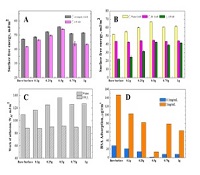
Figure: (A) Apparant total surface free energy of PMPC grafted surfaces with different monomer concentration. (B) Individule CAH surface free energy of PMPC grafted surfaces calculated from water, diiodomethane contact angles and the electron-donor parameter gs- calculated from LWAB method. (C) Work of adhesion of water and diiodomethane to PMPC grafted surfaces; (D) BSA adsorption on the bare surface and PMPC modified surface.
Saad R Ahmed
University of Missouri, Columbia
Title: Experimental and simulation study of tension properties of unsaturated reinforced polyester at low temperature
Time : 16:55-17:20

Biography:
Saad Ahmed is a PhD candidates in Mechanical and Aerospace Engineering school in University of Missouri Columbia.. Over 7 years, experience of working on a milestone driven as well as economically competitive projects for the development and commercialization of innovative materials. Extensive knowledge and experience in the material characterization and specifications measurement techniques for the industrial materials of manufacturing to provide optimized design. He hands on experience on the experimental and computational fluid dynamics. Creative individual with excellent problem solving skills and practical sense of connecting science and technology.
Abstract:
The cryogenic properties of polymers have received great attention with new developments in military and petrochemical processes that require operation at low temperature. This paper presents the evaluation of unsaturated reinforced polyester under static and dynamic loading at extreme temperatures. An environmental chamber was used to test the influence of sub-zero process temperatures on the tensile properties of the specimens. Simulation of tensile properties has be conducted by LS-DYNA and compared with the experimental results. Microstructure examination of the specimens after failure is conducted and evaluated.
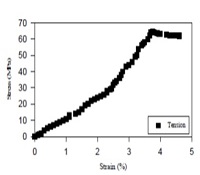
Figure: Typical stress versus strain curves in tension and compression for the polyester resin.
Header Haddad
Swinburne University of Technology, Australia
Title: Optimization of thermal and mechanical properties of unsaturated polyester resin as a binder in polymer concrete for manufacturing precision tool machine base
Time : 17:20-17:55

Biography:
Header Haddad has expertise in evaluation and passion in improving the thermosetting polymer for composite materials in manufacturing the base of precision tool machine. His approach is based on application requirements and how to develop new methods to optimize the composite material through polymer and the aggregates of the composite materials. Another applications that Header researched are injection moulding and blow moulding. Headers research is all industrial based in connection with well-known companies such as ANCA.
Abstract:
This study investigates the effect of unsaturated polyester resin chemical composition on the coefficient of thermal expansion, damping properties, flexural strength, tensile strength and hardness. The resin was used as binder in polymer concrete for manufacturing the base of precision tool machine. Resins of various ratios of styrene-ARAPOL and methyl methacrylate (MMA)-ARAPOL were made and curing kinetics were followed using viscosity measurements and exothermic reaction temperature profile. The resins were studied using dynamic mechanical analysis and in house thermal expansion measuring devices. It was found that ARAPOL–MMA (60:40) has the highest damping factor 5.46%, and the thermal expansion coefficient of 7.98×10-5/°C. This composition also has the optimum flexural strength and tensile strength at 128 MPa and 5.86 MPa.
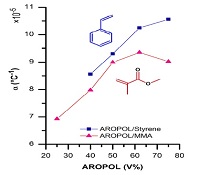
Figure: Coefficient of thermal expansion of MMA and styrene – AROPOL resins.
- Polymer Nanotechnology | Polymer Chemistry | Composite Polymeric Materials
Location: London

Chair
Nekane Guarrotxena
Spanish National Research Council (CSIC), Spain
Session Introduction
Ebru Basaran
Anadolu University, Turkey
Title: Polymeric nanoparticles for antifungal ocular theraphy
Time : 12:25-13:00

Biography:
Dr. Ebru BaÅŸaran has completed her PhD study with the thesis entitled “Formulation and In Vitro - In Vivo Evaluation of Cyclosporine A Incorporated Solid Lipid Nanoparticles, Microemulsion and Polymeric Nanoparticles Aiming Ocular Application” at the Anadolu University Faculty of Pharmacy at Pharmaceutical Technology Department in 2007. The doctorate study was awarded by NAGAI Foundation as the “Best Research Work” at FAPA meeting in 2008. She focused on formulation and characterization of nano-microparticulate delivery systems for ocular application. Currently Dr. BaÅŸaran is working as an Assoc. Prof. at the Anadolu University Faculty of Pharmacy Department of Pharmaceutical Technology since 2017.
Abstract:
Voriconazole (VOR) is a triazole antifungal derived from fluconazole is very active against various fungi including those resistant to fluconazole.1 Treatment of ocular fungal infections remains problematic because of the relatively short list of available therapeutic agents.2 Limited ocular bioavailability of active agents due to the characteristic properties of the eye also limits the efficacy of the treatment. Therefore main approaches for the enhancement of ocular bioavailability of the formulations applied are enhancement of the residence time of the active material at the site of action or enhancement of the ocular penetration of the primary penetration site.
MATERIALS and METHODS
Voriconazole was kindly gifted by Deva Holding (Çerkezköy, TekirdaÄŸ), Eudragit® RS 100 was purchased from Röhm Pharma Polymers (Darmstadt, Germany) and methanol was from Merck (Darmstadt, Germany). All other chemicals used were analytical grade.
FORMULATION OF POLYMERIC NANOPARTICLES
Spray drying method (Büchi B-190, BÜCHI Labortechnik AG, Switzerland) was used for the preparation of polymer based nanoparticles.4 Compositions of the selected formulations were given in Table 1.
CHARACTERIZATION STUDIES OF POLYMERIC NANOPARTICLES
SEM, particle size, polydispersity index, zeta potential analyses were performed. In order to evaluate changes of the polymeric structure DSC analyses were also performed. A validated HPLC method was used for the determination of incorporated PTX.
RESULTS and DISCUSSION
Morphological analyses showed that particles are round in shape (Figure 1).
Particle size, polydispersity index, zeta potential analyses with incorporated VOR amount of the formulations were given in Table 2.
Analyses results revealed that the particle sizes were in the nanometer range with homogenous size distribution (Table 2) with no changes in the polymeric structure (Fig. 2).
CONCLUSION
As a conclusion VOR incorporated polymeric nanoparticles were successfully formulated by spray drying method aiming efficient treatment of ocular fungal infections. In vitro and in vivo efficacy of the formulations will be studied as the second part of the study.
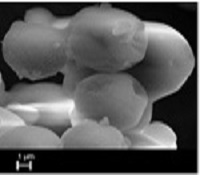
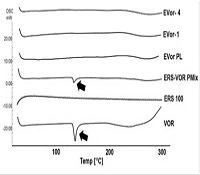
Figure: SEM image of polymeric spheres Figure: DSC analyses of the formulations prepared
Lunch Break 13:00-13:55 @ Athens
M V N Ambika prasad
Gulbarga University, India
Title: Studies of conducting polymers nanocomposites and its applications
Time : 13:55-14:30

Biography:
M V N Ambika Prasad has received MSc degree in Physics from Osmania University, Hyderabad and PhD in Physics from Indian Institute of Technology (IIT), New Delhi. He is currently a Professor of Physics at Gulbarga University, Gulbarga. His research interest includes conducting polymer and nanocomposites, understanding the electrical and thermal behaviour of the materials at nano size and sensing behaviors of various conducting polymers exposed to gas and humidity.
Abstract:
The Polyaniline (PANI) has emerged as one of the most promising conducting polymers, because of its wide spread applications and due to the combination of unique properties like simple preparation and doping procedure, good environmental stability, relatively high conductivity and low cost. The inorganic–organic composites containing polymer as the organic base and Gallium oxide, Vanadium Pentoxide and Indium oxide as inorganic part have been used for studying its gas sensing. These composites have been synthesized by insitu deposition technique by placing fine grade Ga2O3, In2O3 and V2O5 in polymerization mixture of aniline. The results are well supported by FTIR spectra, SEM, XRD and Conductivity measurements. High temperature, conductivity measurements show thermal activated behavior. It is observed that electrical resistance increases with an increase in the temperature. In case of PANI-V2O5,PANI-In2O3 and PANI-Ga2O3 composites both the PANI sensing mechanism of swelling and sensing mechanism of surface charge are responsible for variation of resistance within the sensing material. Therefore, it is observed that PANI-V2O5,PANI-In2O3 and PANI-Ga2O3 composites to be a competent sensing material for LPG and this may be due to formation of surface charge and presence of capillary pores. Similar behavior for the Polymer / Nano metal oxide composites such has Polyaniline-Tungsten oxide, Polyaniline-Cobalt oxide and Polyaniline- Cerium oxide have been observed for its humidity and Gas sensing. Similarly,conducting polymers have found to have applications in Biology in Bio sensors,anti bacterial action, pigeon pea plant growth, microwave absorbers etc.
Yi Luo
Dalian University of Technology, China
Title: Origins of selectivity and activity of olefi n polymerization catalyzed by rare earth metal complexes
Time : 14:30-15:05

Biography:
Yi Luo received his PhD degree in Material Chemistry from Tohoku University in 2004, supervised by Prof. Akira Miyamoto. He has his expertise in computational organometallic chemistry. In the field of computational chemistry, his research interests include rare-earth metal catalyzed polymerizations. He has also contributed good works on intermetallic cooperation towards activation of chemical bond, including C=C double bond. He is active in his scientific research and often collaborates with experimentalists to discover new chemistry together. The effect of THF molecule on olefin polymerization catalyzed by rare earth metal complexes, which was a long-term concern in this field, have been clarified in his multiple research works. It has been proposed that, at the molecular level, the generation of catalytically active species and its chemical hardness could account for the polymerization activity.
Abstract:
Rare-earth metal complexes as a kind of polymerization catalyst usually show unique polymerization activity and selectivity and therefore afford various microstructures of the resulting polymers, not achievable via. transition metal analogues. Mechanism-based rational design of catalyst provides an attractive way towards new polymer materials with desired properties. In this context, theoretical calculations can help in many ways. Charactering catalytic active species, clarifying the mechanism behind experimental phenomenon, and dynamic modeling of polymerization process are just a few examples. With an increase in computer technology and more robust algorithms, computational chemistry has become a viable option for molecular studies in the field of polymer chemistry. In this talk, computational investigations on the molecular mechanism of polymerization catalyzed by rare-earth metal complexes will be introduced. The polymerization mechanisms of conjugated dienes, styrene, and 1-hexene will be covered in the presentation. Especially, the origins of experimentally observed regio- and stereo-selectivity as well as activity suggested by theoretical calculations will be discussed. The polymerization mechanism of lactone and vinyl polar monomers will be also included.
Saul Sanchez-Valdés
Applied Chemistry Research Center (CIQA), Mexico
Title: Photo-stability of low-density polyethylene and ethylene vinyl acetate blends with nanoclay: Towards durable nanocomposites for agricultural fi lms
Time : 15:05-15:40

Biography:
Saul Sanchez has him expertise in preparation and characterization of polymer nanomaterials. He is a senior researcher at Applied Chemistry Research Center (CIQA) for more than 29 years. He received his PhD in Materials Engineering from the UANL in Mexico. He has published more than 70 technical papers, 6 patents and 3 books related with polymer material science, and has supervised more than 20 MSc and PhD thesis. His research work at CIQA has been related most with: polymer processing, polymer nanocomposite materials, polymer functionalization and characterization.
Abstract:
Polyethylene / ethylene vinyl acetate films are prepared and characterized in the presence of three different organo-modified clays. Two organo-modified clays, C20A and I28E, with different type of surfactant, in terms of polarity and number of tallows, is analyzed. The influence of clay organo-modifier on film morphology, mechanical and photo-oxidative degradation performance is studied. As well as the effect of the incorporation of a maleic anhydride grafted Polyethylene (PEgMA) as compatibilizer. The combined effect of these clays with two different UV-oxidative protection systems for PE/EVA nanostructured films is evaluated. Two types of UV stabilizer combination systems is used. One, designed as MB-A with a heat and light stabilizers of blends of antioxidants (phenolic and metal deactivator, Irgatec NC66) with hindered amines, Tinuvin 494AR and other, designed as MB-B with blends of metal deactivator antioxidant, Irganox MD1024 with hindered amines Tinuvin NOR 371 and benzophenones, Chimasorb 81. A strong influence is observed in the use of compatibilizing agent, type and content of nanoclay in the degree of dispersion as well as in the photo-oxidation behavior. The structure obtained is very dependent on the modified clay used; mostly, intercalated-exfoliated structure is produced. These films can be an attractive option for agricultural greenhouse cover films since the clay enhance the greenhouse effect reducing the passage of infrared radiation from the soil during the night maintaining warmer the film covered atmosphere.
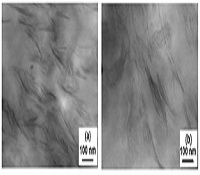
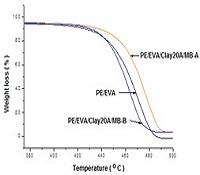
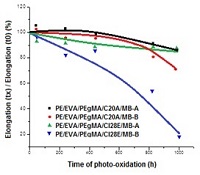
Figure: STEM images of: (a) PE/EVA/C20A (b) PE/EVA/I28E Figure: TGA of PE/EVA/Clay with two types of UV stabilizers Figure: Elongation change with time of photo-oxidation
Sara P Magalhães da Silva
Aveiro Institute of Materials, Portugal
Title: Green composites based on cork residues for additive manufacturing
Time : 16:00-16:25
Biography:
Sara P. Magalhães da Silva has a Master in Chemical Engineering and she is a PhD student of Materials Science and Engineering at University of Aveiro, Portugal. Her field of research is related to the development and characterization of thermoplastic composites for injection molding applications; development of new materials formulations for additive manufacturing; lignocellulosic residues valorization. This work is part of her PhD thesis entitled “Cork-polymer composites – A sustainable solution in injection molding and additive manufacturing”.
Abstract:
Statement of the Problem: An important stage of materials development is the validation of its mechanical performance prior to the manufacturing step. In composite materials, mechanical properties are highly dependent on the interaction between polymer matrix and the filler1-3. Cork-polymer composites (CPC) based on biodegradable matrices for fused filament fabrication (FFF) technique were prepared. FFF, an additive manufacturing (AM), is an extrusion-based technique, in which a thermoplastic filament is melted and selectively extruded via nozzle, deposited layer by layer4. Cork is the outer bark of Quercus Suber L. oak tree and possesses an unique combination of properties: low density, viscoelasticity, high recovery capacity after impact, among others5. Biodegradable polymers as neat polylactic acid (PLA) and PLA/Polyhydroxyalkanoate (PHA) blend were used as matrices in composites formulation. The selection of an elastomeric blend, PLA/PHA, was based on the compatibility of the elastic behavior of cork and to print a more flexible product. In order to evaluate the adhesion between cork and the polymeric matrices, morphological, chemical and mechanical analyses were performed.
Methodology: CPC were prepared using cork powder residues from industrial stoppers production. Both PLA/PHA blend and CPC were prepared by melt compounding. Morphological analyses were made by scanning electron microscopy (SEM); chemical analyses by Fourier Transform Infra-Red (FTIR); and, mechanical tests (tensile, flexural and impact).
Findings: Morphological and chemical analyses revealed a good adhesion of cork to the biodegradable matrices. When cork was incorporated in neat PLA, led to a more flexible material. Conclusion: The incorporation of cork powder residues into biodegradable matrices results on the development of sustainable green composites. AM techniques can add value to these green composites by employing them as filaments for FFF. Combining FFF with the unique cork properties and aesthetics, can potential new design freedom solutions and products.
Padmaja Guggilla
Alabama A&M University, USA
Title: Reducing the bandgap energy via doping process in lead-free thin fi lm nanocomposites
Time : 16:25-17:00

Biography:
Padmaja Guggilla has completed her PhD from Alabama A&M University in 2007. She is presently working as Associate Professor of Physics at Alabama A&M University. She has published more than 45 papers in reputed journals and has been serving as an Editorial Board Member of reputed journals. She has secured over 2 million dollars of extramural funds as Principal Investigator in the last five years
Abstract:
There are numerous applications for the pyroelectric composite films in the medical field, military field and environmental applications field. The main focus of this research is to fabricate the higher efficiency thin films that are flexible like the polymers. PVDF is ideal when it comes to making detectors as they are flexible; possess high pyroelectric current and resistance, low dielectric constant and density. Pure PVDF and PVDF films doped with CNT and MWCNT, PVDF: LiTaO3, PVDF:LiTaO3 films doped with MWCNT thin films were fabricated using the solution casting technique. Evaluated the deposited films’ electrical, optical and structural properties using SEM, FTIR Spectroscopy, UV-Vis Spectroscopy, and Raman Spectrum. Results show that doping with CNT and MWCNT is enhancing the key characteristics that are beneficial for the optical devices industry.
Usman Yaqoob
University of Ulsan, Republic of Korea
Title: Synthesis of high dielectric constant fl exible piezoelectric sheet using P(VDF-TrFE)-BTO-rGO composite and its application to energy harvesting
Time : 17:00-17:25

Biography:
Usman Yaqoob received his B.Sc. from the School of Electronics Engineering, International Islamic University Islamabad, Islamabad, Pakistan, in 2013. He is now working as a Ph.D. candidature in the School of Electrical Engineering, University of Ulsan, Ulsan, South Korea. His research interests include WO3, CNTs, graphene based flexible nanosensors and flexible piezoelectric nanogenerators.
Abstract:
Piezoelectric materials have attracted considerable attention due to their ability to scavenge electrical energy directly from ambient mechanical sources. The energy harvesting from these materials can be a promising way to phase out conventional batteries and power cables. Over the past few decades, considerable efforts have been made to develop a flexible piezoelectric material that possesses high dielectric constant and high breakdown strength by combining polymer-ceramic composites. However, high amount of ceramic filer (>50 vol%.) is required to obtain the maximum dielectric constant (k) from the composite material which can reduce the mechanical flexibility of the composite film. To address this matter, and for further enhancement in k value, a possible solution is to employ a conductive filler. The introduction of conductive filler will not only elevate the dielectric constant by forming several micro-capacitors inside the composite but will also assist in the stabilization of the polar beta (β) phase of the P(VDF-TrFE). The polar β phase of polymer is highly required to obtain maximum energy harvesting properties. Herein, we presents the synthesis and optimization of flexible piezoelectric materials based on poly(vinylidenefluoride)-reduced graphene oxide-barium titanate (PVDF-RGO-BTO) for its application in energy harvesting. To obtain the maximum dielectric constant, different compositions have been prepared by varying the reduced graphene oxide (RGO) contents in the PVDF-BTO nanocomposition. The sample with 5wt% RGO contents (PRB5) has revealed maximum dielectric constant of 170 at 1 kHz. Therefore, has been selected to fabricate the piezoelectric nanogenerator (PENG). The fabricated PENG exhibits maximum open circuit voltage of 4 V(pk-pk) and short-circuit current of 1.5 μA(pk-pk) at an applied force of 2N. Additionally, the maximum output power for the fabricated PENG was recorded around 3.8 μW at 1 MΩ load resistance. It was estimated that fabricated PENG can be a promising energy source for futuristic flexible electronics.
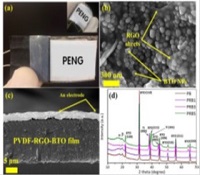
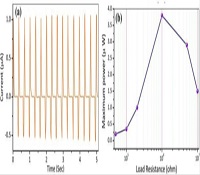
Closing Cermony

